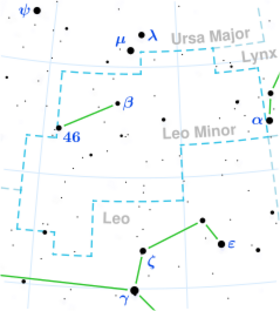Astronomy:30 Leonis Minoris
| Observation data Equinox J2000.0]] (ICRS) | |
|---|---|
| Constellation | Leo Minor |
| Right ascension | 10h 25m 54.81535s[1] |
| Declination | 33° 47′ 46.0309″[1] |
| Apparent magnitude (V) | 4.72[2] |
| Characteristics | |
| Spectral type | kF0hF2mF2[3] or A9IIIa[4] |
| U−B color index | +0.18[5] |
| B−V color index | +0.25[5] |
| Astrometry | |
| Radial velocity (Rv) | +13.70[6] km/s |
| Proper motion (μ) | RA: -73.66[1] mas/yr Dec.: -59.21[1] mas/yr |
| Parallax (π) | 13.98 ± 0.21[1] mas |
| Distance | 233 ± 4 ly (72 ± 1 pc) |
| Absolute magnitude (MV) | 0.45[2] |
| Details | |
| Mass | 2.28[7] M☉ |
| Radius | 4.182[8] R☉ |
| Luminosity | 58[7] L☉ |
| Surface gravity (log g) | 3.82[9] cgs |
| Temperature | 7,292[9] K |
| Metallicity [Fe/H] | +0.19[9] dex |
| Rotational velocity (v sin i) | 34[7] km/s |
| Other designations | |
| Database references | |
| SIMBAD | data |
30 Leonis Minoris is a single[11] star in the northern constellation of Leo Minor. It is visible to the naked eye as a faint, white-hued point of light with an apparent visual magnitude of 4.72.[2] The distance to this star, as estimated from parallax measurements, is 233 light years.[1] It is drifting away from the Earth with a heliocentric radial velocity of +13.7 km/s.[6]
This object has been catalogued as an Am star[12] and was given a stellar classification of kF0hF2mF2[3] by Abt and Morrell (1995). This notation indicates the calcium K line matches an F0 star, while the hydrogen and metal lines fit an F2 star. However, Gray et al. (2001) assigned it a class of A9IIIa,[4] matching an A-type giant star.
30 Leonis Minoris has 2.3[7] times the mass of the Sun and 4.2[8] times the Sun's radius. It has a moderate rate of spin, showing a projected rotational velocity of 34 km/s.[7] The star is radiating 58[7] times the Sun's luminosity from its photosphere at an effective temperature of 7,292 K.[9]
References
- ↑ 1.0 1.1 1.2 1.3 1.4 1.5 Van Leeuwen, F. (2007). "Validation of the new Hipparcos reduction". Astronomy and Astrophysics 474 (2): 653–664. doi:10.1051/0004-6361:20078357. Bibcode: 2007A&A...474..653V. Vizier catalog entry
- ↑ 2.0 2.1 2.2 Anderson, E.; Francis, Ch. (2012). "XHIP: An extended hipparcos compilation". Astronomy Letters 38 (5): 331. doi:10.1134/S1063773712050015. Bibcode: 2012AstL...38..331A. Vizier catalog entry
- ↑ 3.0 3.1 Abt, Helmut A.; Morrell, Nidia I. (1995). "The Relation between Rotational Velocities and Spectral Peculiarities among A-Type Stars". Astrophysical Journal Supplement 99: 135. doi:10.1086/192182. Bibcode: 1995ApJS...99..135A.
- ↑ 4.0 4.1 Gray, R. O. et al. (April 2001). "The Physical Basis of Luminosity Classification in the Late A-, F-, and Early G-Type Stars. I. Precise Spectral Types for 372 Stars". The Astronomical Journal 121 (4): 2148–2158. doi:10.1086/319956. Bibcode: 2001AJ....121.2148G.
- ↑ 5.0 5.1 Mallama, A. (2014). "Sloan Magnitudes for the Brightest Stars". The Journal of the American Association of Variable Star Observers 42 (2): 443. Bibcode: 2014JAVSO..42..443M.Vizier catalog entry
- ↑ 6.0 6.1 Gontcharov, G. A. (2006). "Pulkovo Compilation of Radial Velocities for 35 495 Hipparcos stars in a common system". Astronomy Letters 32 (11): 759–771. doi:10.1134/S1063773706110065. Bibcode: 2006AstL...32..759G.
- ↑ 7.0 7.1 7.2 7.3 7.4 7.5 Zorec, J.; Royer, F. (2012). "Rotational velocities of A-type stars". Astronomy & Astrophysics 537: A120. doi:10.1051/0004-6361/201117691. Bibcode: 2012A&A...537A.120Z. Vizier catalog entry
- ↑ 8.0 8.1 Masana, E. et al. (2006). "Effective temperature scale and bolometric corrections from 2MASS photometry". Astronomy and Astrophysics 450 (2): 735. doi:10.1051/0004-6361:20054021. Bibcode: 2006A&A...450..735M. Vizier catalog entry
- ↑ 9.0 9.1 9.2 9.3 Wu, Yue et al. (2010). "Coudé-feed stellar spectral library – atmospheric parameters". Astronomy & Astrophysics 525: A71. doi:10.1051/0004-6361/201015014. Bibcode: 2011A&A...525A..71W.
- ↑ "30 LMi". SIMBAD. Centre de données astronomiques de Strasbourg. http://simbad.u-strasbg.fr/simbad/sim-basic?Ident=30+LMi.
- ↑ Eggleton, P. P.; Tokovinin, A. A. (September 2008). "A catalogue of multiplicity among bright stellar systems". Monthly Notices of the Royal Astronomical Society 389 (2): 869–879. doi:10.1111/j.1365-2966.2008.13596.x. Bibcode: 2008MNRAS.389..869E.
- ↑ Shorlin, S. L. S. et al. (September 2002). "A highly sensitive search for magnetic fields in B, A and F stars". Astronomy and Astrophysics 392 (2): 637–652. doi:10.1051/0004-6361:20021192. Bibcode: 2002A&A...392..637S.
 |



